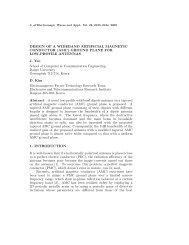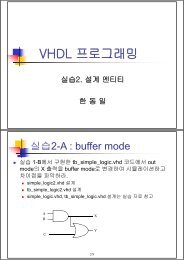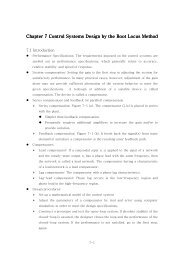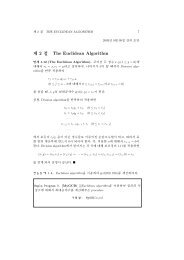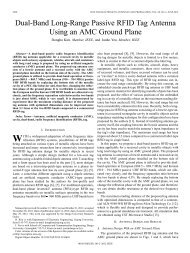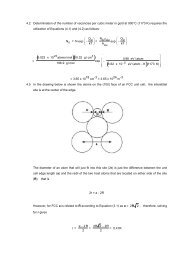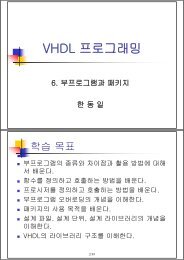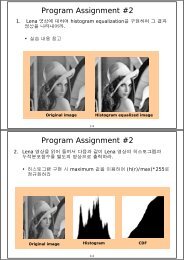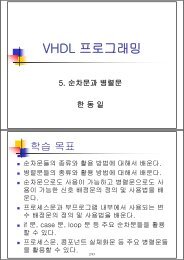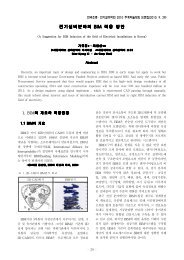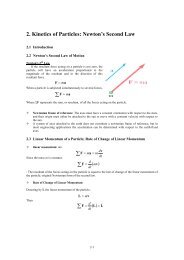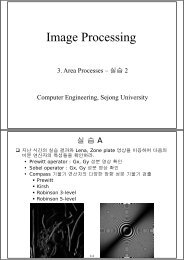Classification of rice cultivars based on cluster analysis of hydration ...
Classification of rice cultivars based on cluster analysis of hydration ...
Classification of rice cultivars based on cluster analysis of hydration ...
You also want an ePaper? Increase the reach of your titles
YUMPU automatically turns print PDFs into web optimized ePapers that Google loves.
168<br />
Table 5<br />
Cluster <strong>analysis</strong> classificati<strong>on</strong> <str<strong>on</strong>g>of</str<strong>on</strong>g> <str<strong>on</strong>g>rice</str<strong>on</strong>g> <str<strong>on</strong>g>cultivars</str<strong>on</strong>g> <str<strong>on</strong>g>based</str<strong>on</strong>g> <strong>on</strong> textural parameters.<br />
Group i Group ii Group iii Group iv Group v<br />
A B C E K<br />
D F L<br />
G H<br />
I<br />
J<br />
not by the classificati<strong>on</strong> <str<strong>on</strong>g>based</str<strong>on</strong>g> <strong>on</strong> amylose c<strong>on</strong>tents (Table 3). The<br />
most important advantage with the new classificati<strong>on</strong> system is<br />
that <str<strong>on</strong>g>cultivars</str<strong>on</strong>g> C, D, and G and <str<strong>on</strong>g>cultivars</str<strong>on</strong>g> E, F, and H have been categorically<br />
placed under two different groups, which bel<strong>on</strong>g to<br />
a single group in the case <str<strong>on</strong>g>of</str<strong>on</strong>g> amylose-<str<strong>on</strong>g>based</str<strong>on</strong>g> classificati<strong>on</strong> (Table 3).<br />
In the classificati<strong>on</strong> <str<strong>on</strong>g>based</str<strong>on</strong>g> <strong>on</strong> pasting parameters, Group iv (<str<strong>on</strong>g>cultivars</str<strong>on</strong>g><br />
E, F, and H) showed higher values <str<strong>on</strong>g>of</str<strong>on</strong>g> peak, trough, final,<br />
breakdown, and setback viscosities than Group iii (<str<strong>on</strong>g>cultivars</str<strong>on</strong>g> C, D,<br />
and G). In the proposed classificati<strong>on</strong> <str<strong>on</strong>g>based</str<strong>on</strong>g> <strong>on</strong> the hydrati<strong>on</strong><br />
parameters and their combinati<strong>on</strong> with pasting properties data,<br />
Group i (<str<strong>on</strong>g>cultivars</str<strong>on</strong>g> C, D, and G) showed lower values <str<strong>on</strong>g>of</str<strong>on</strong>g> WAI and SP<br />
than Group ii (<str<strong>on</strong>g>cultivars</str<strong>on</strong>g> E, F, and H). This <strong>cluster</strong> <strong>analysis</strong> was<br />
successful to classify the <str<strong>on</strong>g>cultivars</str<strong>on</strong>g> C, D, and G and the <str<strong>on</strong>g>cultivars</str<strong>on</strong>g> E, F,<br />
and, H which differ in terms <str<strong>on</strong>g>of</str<strong>on</strong>g> processability. In our previous study<br />
(unpublished report), the protein c<strong>on</strong>tent in <str<strong>on</strong>g>rice</str<strong>on</strong>g> flour <str<strong>on</strong>g>of</str<strong>on</strong>g> cultivar E, F<br />
(6.64 g/100 g), and H (6.12 g/100 g) was found lower than cultivar C<br />
(6.38 g/100 g), D (6.68 g/100 g), and G (6.77 g/100 g). Protein<br />
c<strong>on</strong>tent can be correlated with pasting properties. Therefore, there<br />
are differences in physical characteristics because residue protein<br />
c<strong>on</strong>tent may be lower in starch isolated from <str<strong>on</strong>g>cultivars</str<strong>on</strong>g> E, F, and H<br />
than <strong>on</strong>e <str<strong>on</strong>g>of</str<strong>on</strong>g> <str<strong>on</strong>g>cultivars</str<strong>on</strong>g> G, C, and D. In c<strong>on</strong>clusi<strong>on</strong>, the classificati<strong>on</strong><br />
system <str<strong>on</strong>g>based</str<strong>on</strong>g> <strong>on</strong> pasting and hydrati<strong>on</strong> parameters representing<br />
practical processability is better compared to the c<strong>on</strong>venti<strong>on</strong>al<br />
method <str<strong>on</strong>g>based</str<strong>on</strong>g> <strong>on</strong> amylose c<strong>on</strong>tent.<br />
4. C<strong>on</strong>clusi<strong>on</strong>s<br />
In this study, classificati<strong>on</strong> <str<strong>on</strong>g>of</str<strong>on</strong>g> <str<strong>on</strong>g>rice</str<strong>on</strong>g> <str<strong>on</strong>g>cultivars</str<strong>on</strong>g> was performed <str<strong>on</strong>g>based</str<strong>on</strong>g><br />
<strong>on</strong> the hydrati<strong>on</strong> and the pasting properties <str<strong>on</strong>g>of</str<strong>on</strong>g> their starches. The<br />
<str<strong>on</strong>g>cultivars</str<strong>on</strong>g> having similar amylose c<strong>on</strong>tent are categorized into<br />
different groups under proposed new classificati<strong>on</strong> because their<br />
starches showed different hydrati<strong>on</strong> and pasting properties.<br />
However, some <str<strong>on</strong>g>cultivars</str<strong>on</strong>g> with different amylose c<strong>on</strong>tents are<br />
grouped together into a single category due to the similarity <str<strong>on</strong>g>of</str<strong>on</strong>g><br />
hydrati<strong>on</strong> and pasting properties <str<strong>on</strong>g>of</str<strong>on</strong>g> their starches. Thus, the classificati<strong>on</strong><br />
<str<strong>on</strong>g>of</str<strong>on</strong>g> <str<strong>on</strong>g>rice</str<strong>on</strong>g> starches, in turn, <str<strong>on</strong>g>cultivars</str<strong>on</strong>g> <str<strong>on</strong>g>based</str<strong>on</strong>g> <strong>on</strong> the practical<br />
processability is more appropriate and useful system than the<br />
classical classificati<strong>on</strong> c<strong>on</strong>sidering the amylose c<strong>on</strong>tent <strong>on</strong>ly. This<br />
study provides a resoluti<strong>on</strong> to standardize purpose-specific classificati<strong>on</strong><br />
<str<strong>on</strong>g>of</str<strong>on</strong>g> starches from a variety <str<strong>on</strong>g>of</str<strong>on</strong>g> <str<strong>on</strong>g>rice</str<strong>on</strong>g> <str<strong>on</strong>g>cultivars</str<strong>on</strong>g>. Rice <str<strong>on</strong>g>cultivars</str<strong>on</strong>g><br />
classified within a category <str<strong>on</strong>g>based</str<strong>on</strong>g> <strong>on</strong> practical processability can be<br />
c<strong>on</strong>sidered as uniform even if their chemical compositi<strong>on</strong>s<br />
including amylose c<strong>on</strong>tent are different. Thus, mixture <str<strong>on</strong>g>of</str<strong>on</strong>g> the<br />
starches from different <str<strong>on</strong>g>rice</str<strong>on</strong>g> <str<strong>on</strong>g>cultivars</str<strong>on</strong>g> but possessing similar processing<br />
characteristics can be used for different food applicati<strong>on</strong>s.<br />
In c<strong>on</strong>clusi<strong>on</strong>, <str<strong>on</strong>g>rice</str<strong>on</strong>g> starches categorizati<strong>on</strong> can be simplified and<br />
standardized by using processability parameters despite a variety<br />
<str<strong>on</strong>g>of</str<strong>on</strong>g> <str<strong>on</strong>g>rice</str<strong>on</strong>g> <str<strong>on</strong>g>cultivars</str<strong>on</strong>g>. This classificati<strong>on</strong> strategy can be expanded to<br />
categorize <str<strong>on</strong>g>rice</str<strong>on</strong>g> <str<strong>on</strong>g>cultivars</str<strong>on</strong>g> suited for properties <str<strong>on</strong>g>of</str<strong>on</strong>g> precooked dried<br />
<str<strong>on</strong>g>rice</str<strong>on</strong>g>, <str<strong>on</strong>g>rice</str<strong>on</strong>g> noodle, and bakery products when the classificati<strong>on</strong> is<br />
I. Lee et al. / LWT - Food Science and Technology 48 (2012) 164e168<br />
carried out <str<strong>on</strong>g>based</str<strong>on</strong>g> <strong>on</strong> the parameters that represent practical<br />
processabilities.<br />
Acknowledgments<br />
This study was supported by “Cooperative Research Program for<br />
Agricultural science and technology development (Project No.<br />
PJ007172)” Rural Department Administrati<strong>on</strong>, Republic <str<strong>on</strong>g>of</str<strong>on</strong>g> Korea.<br />
References<br />
Adebowale, K. O., & Lawal, O. S. (2003). Functi<strong>on</strong>al properties and retrogradati<strong>on</strong><br />
behaviour <str<strong>on</strong>g>of</str<strong>on</strong>g> native and chemically modified starch <str<strong>on</strong>g>of</str<strong>on</strong>g> mucuna bean (Mucuna<br />
pruriens). Journal <str<strong>on</strong>g>of</str<strong>on</strong>g> the Science <str<strong>on</strong>g>of</str<strong>on</strong>g> Food and Agriculture, 83, 1541e1546.<br />
Bhattacharya, M., Zee, S. Y., & Corke, H. (1999). Physicochemical properties related<br />
to quality <str<strong>on</strong>g>of</str<strong>on</strong>g> <str<strong>on</strong>g>rice</str<strong>on</strong>g> noodles. Cereal Chemistry, 76, 861e867.<br />
Choi, H. C. (2002). Current status and perspectives in varietal improvement <str<strong>on</strong>g>of</str<strong>on</strong>g> <str<strong>on</strong>g>rice</str<strong>on</strong>g><br />
<str<strong>on</strong>g>cultivars</str<strong>on</strong>g> for high-quality and value-added products. Korean Journal <str<strong>on</strong>g>of</str<strong>on</strong>g> Crop<br />
Science, 47, 15e32.<br />
Crosbie, G. B. (1991). The relati<strong>on</strong>ship between starch swelling properties, paste<br />
viscosity and boiled noodle quality in wheat flours. Journal <str<strong>on</strong>g>of</str<strong>on</strong>g> Cereal Science, 13,<br />
145e150.<br />
Endo, S., Okada, K., Nagao, S., & D’appl<strong>on</strong>ia, B. L. (1990). Quality characteristics <str<strong>on</strong>g>of</str<strong>on</strong>g><br />
hard red spring and winter wheats. II. Statistical evaluati<strong>on</strong>s <str<strong>on</strong>g>of</str<strong>on</strong>g> reversed-phase<br />
high-performance liquid chromatography and milling data. Cereal Chemistry, 67,<br />
486e489.<br />
Ha, S., Roh, Y. W., H<strong>on</strong>g, K. P., Kang, Y. S., Jung, D. C., Kim, K. H., et al. (2007). Textural<br />
properties <str<strong>on</strong>g>of</str<strong>on</strong>g> processed foods produced from newly developed n<strong>on</strong>-glutinous<br />
<str<strong>on</strong>g>rice</str<strong>on</strong>g> <str<strong>on</strong>g>cultivars</str<strong>on</strong>g>. Food Science and Biotechnology, 16, 789e795.<br />
Hall, V. L., & Johns<strong>on</strong>, J. R. (1966). A revised starch-iodine blue test for raw milled<br />
<str<strong>on</strong>g>rice</str<strong>on</strong>g>. Cereal Chemistry, 43, 297e302.<br />
Juliano, B. O. (1985). Rice: Chemistry and technology. St. Paul, MN: American Assosicati<strong>on</strong><br />
<str<strong>on</strong>g>of</str<strong>on</strong>g> Cereal Chemistry.<br />
Karim, A. A., Norziah, M. H., & Seow, C. C. (2000). Methods for the study <str<strong>on</strong>g>of</str<strong>on</strong>g> starch<br />
retrogradati<strong>on</strong>. Food Chemistry, 71, 9e36.<br />
Kum, J. S., Lee, S. H., Lee, H. Y., & Lee, C. (1996). Retrogradati<strong>on</strong> behavior <str<strong>on</strong>g>of</str<strong>on</strong>g> <str<strong>on</strong>g>rice</str<strong>on</strong>g><br />
starches differing in amylose c<strong>on</strong>tent and gel c<strong>on</strong>sistency. Korean Journal <str<strong>on</strong>g>of</str<strong>on</strong>g> Food<br />
Science and Technology, 28, 1052e1058.<br />
Lee, S. H., Han, O., Lee, H. Y., Kim, S. S., & Chung, D. H. (1989). Physicochemical<br />
properties <str<strong>on</strong>g>of</str<strong>on</strong>g> <str<strong>on</strong>g>rice</str<strong>on</strong>g> starch by amylose c<strong>on</strong>tent. Korean Journal <str<strong>on</strong>g>of</str<strong>on</strong>g> Food Science and<br />
Technology, 21, 766e771.<br />
Li, J. Y., & Yeh, A. I. (2001). Relati<strong>on</strong>ships between thermal, rheological characteristics<br />
and swelling power for various starches. Journal <str<strong>on</strong>g>of</str<strong>on</strong>g> Food Engineering, 50,<br />
141e148.<br />
Limpisut, P., & Jindal, V. K. (2002). Comparis<strong>on</strong> <str<strong>on</strong>g>of</str<strong>on</strong>g> <str<strong>on</strong>g>rice</str<strong>on</strong>g> flour pasting properties using<br />
brabender viscoamylograph and rapid visco analyser for evaluating cooked <str<strong>on</strong>g>rice</str<strong>on</strong>g><br />
texture. Starch e Stärke, 54, 350e357.<br />
Medcalf, D. G., & Gilles, K. A. (1965). Wheat starches. I. Comparis<strong>on</strong> <str<strong>on</strong>g>of</str<strong>on</strong>g> physicochemical<br />
properties. Cereal Chemistry, 42, 558e568.<br />
Miles, M. J., Morris, V. J., Orford, P. D., & Ring, S. G. (1985). The roles <str<strong>on</strong>g>of</str<strong>on</strong>g> amylose and<br />
amylopectin in the gelati<strong>on</strong> and retrogradati<strong>on</strong> <str<strong>on</strong>g>of</str<strong>on</strong>g> starch. Carbohydrate Research,<br />
135, 271e281.<br />
Mitchell, C. R. (2009). Rice starches: producti<strong>on</strong> and properties. In J. BeMiller, &<br />
R. Whistler (Eds.), Starch: Chemistry and technology (pp. 570). New York:<br />
Academic Press.<br />
Morris<strong>on</strong>, W. R., Tester, R. F., Snape, C. E., Law, R., & Gidley, M. J. (1993). Swelling and<br />
gelatinizati<strong>on</strong> <str<strong>on</strong>g>of</str<strong>on</strong>g> cereal starches. IV. Some effects <str<strong>on</strong>g>of</str<strong>on</strong>g> lipid-complexed amylose<br />
and free amylose in waxy and normal barley starches. Cereal Chemistry, 70,<br />
385e389.<br />
Schoch, T. J. (1964). Swelling power and solubility <str<strong>on</strong>g>of</str<strong>on</strong>g> granular starches.<br />
InWhistler, R. L. (Ed.). (1964). Methods in carbohydrate chemistry, Vol. IV (pp.<br />
106e108). New York: Academic Press.<br />
Tester, R. F., & Morris<strong>on</strong>, W. R. (1990). Swelling and gelatinizati<strong>on</strong> <str<strong>on</strong>g>of</str<strong>on</strong>g> cereal starches.<br />
I. Effects <str<strong>on</strong>g>of</str<strong>on</strong>g> amylopectin, amylose, and lipids. Cereal Chemistry, 67, 551e557.<br />
Wiesenborn, D. P., Orr, P. H., Casper, H. H., & Tacke, B. K. (1994). Potato starch paste<br />
behavior as related to some physical/chemical properties. Journal <str<strong>on</strong>g>of</str<strong>on</strong>g> Food<br />
Science, 59, 644e648.<br />
Williams, P. C., Kuzina, F. D., & Hlynka, I. (1970). A rapid colorimetric procedure for<br />
estimating the amylose c<strong>on</strong>tent <str<strong>on</strong>g>of</str<strong>on</strong>g> starches and flours. Cereal Chemistry, 47,<br />
411e421.<br />
Yamamoto, K., Sawada, S., & Onogaki, T. (1973). Properties <str<strong>on</strong>g>of</str<strong>on</strong>g> <str<strong>on</strong>g>rice</str<strong>on</strong>g> starch prepared by<br />
alkali method with various c<strong>on</strong>diti<strong>on</strong>s. Denpun Kagaku, 20, 99e104.<br />
Yo<strong>on</strong>, M. R., Koh, H. J., & Kang, M. Y. (2009). Pasting and amylose comp<strong>on</strong>ent<br />
characteristics <str<strong>on</strong>g>of</str<strong>on</strong>g> seven <str<strong>on</strong>g>rice</str<strong>on</strong>g> <str<strong>on</strong>g>cultivars</str<strong>on</strong>g>. Journal <str<strong>on</strong>g>of</str<strong>on</strong>g> the Korean Society for Applied<br />
Biological Chemistry, 52, 63e69.



